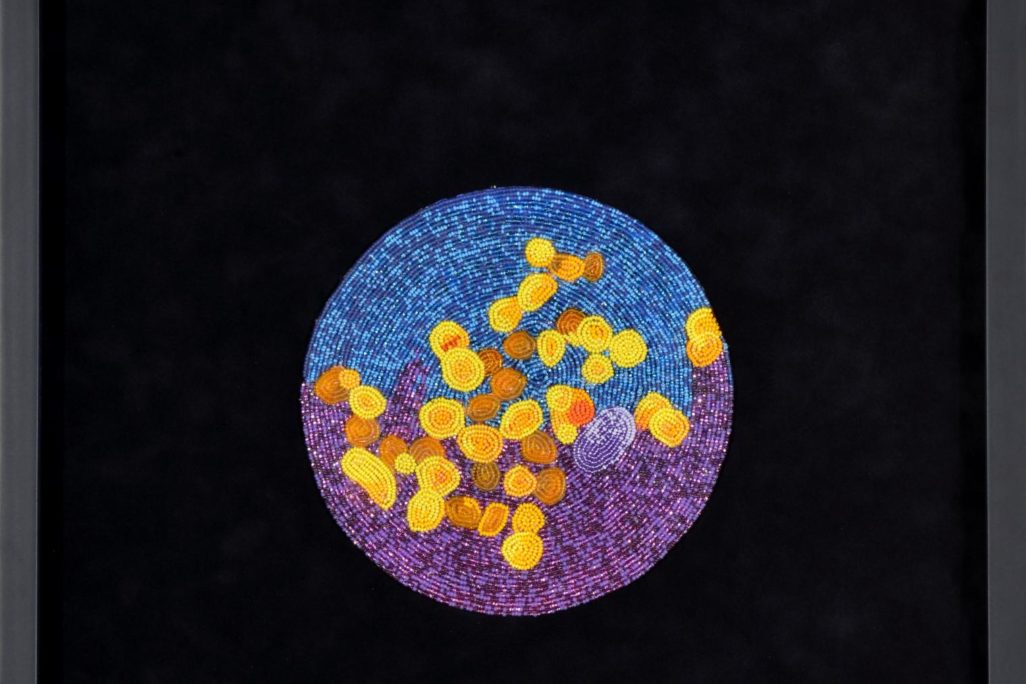Studio Sunday Hybrid: Ruth Cuthand: Surviving: COVID-19
About
Ruth Cuthand uses artwork to have difficult conversations. Create a three-part drawing to share your personal COVID–19 experiences, and open up discussions around your feelings during this global pandemic.
Please note: This Studio Sunday includes discussion about the COVID–19 pandemic. We are hoping it will be useful in facilitating discussions within families, however please use your best judgement on your children’s comfort level with the topic. This pandemic has provided us with many challenges. If you require mental health support please consider the following resources:
About the Artwork
Ruth Cuthand’s most recent work, Surviving: COVID-19, reminds us of the disproportionate effect this new virus has had on Indigenous communities both in Saskatchewan and elsewhere. It brings into the present moment her Trading Series (2009), in which she reflects on the pandemics and epidemics that have historically affected Indigenous communities both locally and globally. For this earlier series, Cuthand created seductive and sinister images of the viruses and bacteria brought by Europeans to the Americas, such as typhoid fever, chicken pox, whooping cough, measles, and, most devastating of all, smallpox. These hauntingly beautiful images expose the terrible exchange which saw glass beads traded for epidemics of disease, beauty for destruction, and in later times medical knowledge for cultural understanding. The images also allude to a Cree understanding of the world. The word for bead in Cree is animate, meaning it is alive; this subtle cultural reference points to her work—and the viruses they represent—as living beings.
For more information, watch Curatorial Fellow Felicia Gay’s interview with Ruth Cuthand on Surviving: COVID-19. WATCH THE INTERVIEW.
You can explore Ruth Cuthand’s Trading Series online: TRADING SERIES – RUTH CUTHAND.
About the Artist
Ruth Cuthand was born in Prince Albert, Saskatchewan in 1954, but grew up near the Blood Reserve in Alberta. A Plains Cree and Scottish/Irish artist, much of her work explores the frictions between cultures, the failures of representation, and the political uses of anger.
Cuthand began her formal study of art in 1977 at the University of Regina, although her interest in art originated much earlier. Initially, Cuthand studied printmaking, but due to a chemical allergy she turned from the toxicity of printmaking methods to the practice of painting. She left the University of Regina to have her second child and returned to art school at the University of Saskatchewan, obtaining her Bachelor of Fine Arts in 1983. She continued her training in the University of Montana’s Master of Fine Arts program in 1985, while producing the important works in her series of dress paintings – a major breakthrough in her practice.
After obtaining her Master of Fine Arts from the University of Saskatchewan, Cuthand expanded her practice to include drawing, photography, and beadwork. Cuthand has been the recipient of the Lieutenant Govenor’s Arts Award (2013), and the Governor General’s Award in Visual and Media Arts (2020).
THINGS TO THINK ABOUT
- Surviving: COVID–19 and the works in Trading Series are surprisingly beautiful, even though they portray things that are quite frightening. Why would an artist portray something scary in a beautiful way?
- Ruth Cuthand uses tools like humour and beauty to have hard conversations. How do you have hard conversations with friends or family?
- After watching the Felicia Gay interview with Ruth Cuthand (https://youtu.be/yupq1_nzbWA):
- What positive things did Ruth Cuthand say she saw happening in reserve communities during the pandemic? What other ways do people work together during difficult times?
- Cuthand talks about how Indigenous feminism differs from Euro-centric feminism. Can you think of any other social movements that might look different through an Indigenous lens?
Post your artwork online using the hashtag #studiosundaysyqr!
Studio Activity
Ruth Cuthand uses artwork to have difficult conversations. Create a three-part drawing to share your personal COVID–19 experiences, and open up discussions around your feelings during this global pandemic.
What you Need:
- Drawing template (found here), or blank paper
- Pencils and erasers
- Markers or pencil crayons
What you Do:
- Parents: Begin this activity by asking your children/students if discussing their feelings around COVID–19 is something they are comfortable with. If you need further assistance with this, feel free to use the resource listed above from Public Health Canada for parents and children.
- Look at Ruth Cuthand’s image Surviving: COVID-19 and have a discussion about how art can help us understand each other and the world around us, supporting difficult conversations and growth.
- Ask children/students to think about three important moments that they have had during this pandemic:
- A moment that made you happy or comforted during this time.
- A memory of a challenge you faced because of Covid–19, and how you dealt with it. (This does not have to be your biggest challenge in the last year. If thinking about that makes you uncomfortable, you could try to think of some of the smaller challenges or skip this section altogether.)
- A thought you have had about your hopes for the future, such as what life will look like as we move beyond Covid-19.
- Draw an image of each memory or thought in the template, or by dividing a paper into three. If you chose to skip the middle memory, think about creative ways to fill in that middle panel.
- Have a conversation with a family member or friend about what you drew.

